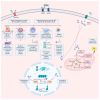Short-Chain Fatty Acids and Human Health: From Metabolic Pathways to Current Therapeutic Implications
- PMID: 38792581
- PMCID: PMC11122327
- DOI: 10.3390/life14050559
Short-Chain Fatty Acids and Human Health: From Metabolic Pathways to Current Therapeutic Implications
Abstract
The gastrointestinal tract is home to trillions of diverse microorganisms collectively known as the gut microbiota, which play a pivotal role in breaking down undigested foods, such as dietary fibers. Through the fermentation of these food components, short-chain fatty acids (SCFAs) such as acetate, propionate, and butyrate are produced, offering numerous health benefits to the host. The production and absorption of these SCFAs occur through various mechanisms within the human intestine, contingent upon the types of dietary fibers reaching the gut and the specific microorganisms engaged in fermentation. Medical literature extensively documents the supplementation of SCFAs, particularly butyrate, in the treatment of gastrointestinal, metabolic, cardiovascular, and gut-brain-related disorders. This review seeks to provide an overview of the dynamics involved in the production and absorption of acetate, propionate, and butyrate within the human gut. Additionally, it will focus on the pivotal roles these SCFAs play in promoting gastrointestinal and metabolic health, as well as their current therapeutic implications.
Keywords: dietary fiber fermentation; gastrointestinal and metabolic health; intestinal microbiota; short-chain fatty acids (SCFAs); therapeutic implications.
Conflict of interest statement
Edoardo Vincenzo Savarino has served as speaker for Abbvie, Agave, AGPharma, Alfasigma, Aurora Pharma, CaDiGroup, Celltrion, Dr Falk, EG Stada Group, Fenix Pharma, Fresenius Kabi, Galapagos, Janssen, JB Pharmaceuticals, Innovamedica/Adacyte, Malesci, MayolyBiohealth, Omega Pharma, Pfizer, Reckitt Benckiser, Sandoz, SILA, Sofar, Takeda, Tillots, Unifarco; has served as a consultant for Abbvie, Agave, Alfasigma, Biogen, Bristol-Myers Squibb, Celltrion, DiademaFarmaceutici, Dr Falk, Fenix Pharma, Fresenius Kabi, Janssen, JB Pharmaceuticals, Merck & Co, Nestlè, Reckitt Benckiser, Regeneron, Sanofi, SILA, Sofar, Synformulas GmbH, Takeda, Unifarco; he received research support from Pfizer, Reckitt Benckiser, SILA, Sofar, Unifarco, Zeta Farmaceutici. Sonia Facchin has served as a consultant for SILA, Unifarco, and Zeta Farmaceutici and has served as a speaker for Unifarco and SILA. Fabiana Zingone has served as a speaker for EG Stada Group, Fresenius Kabi, Janssen, Pfizer, Takeda, Unifarco, Malesci, and Kedrion and has served as a consultant for Galapagos. Brigida Barberio has served as a speaker for Abbvie, Agave, Alfasigma, AGpharma, Janssen, MSD, Procise, Sofar, Takeda, Unifarco. The other authors declare no conflicts of interest.
Figures


References
Publication types
LinkOut - more resources
Full Text Sources
Molecular Biology Databases

